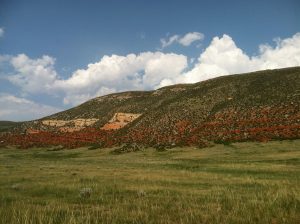 Within Indigenous worldview, the Land is the source of much more than the matter that cycles through plants, animals, soil, air, and water. It is also the source of dreams, stories, information of all kinds, philosophy, law, and almost everything else. Human awareness of the information, stories, and ideas inherent within the Land arises in relationship, which means that important knowledge is neither discovered nor constructed by the human mind. Instead, Indigenous Knowledge is shared with a person or community in relationship with a particular Place. Indigenous Knowledge is seen as the initiator of this process and is therefore said to have agency.* Humans are seen as entering a respectful and reciprocal relationship with Knowledge to learn. Because IK comes from, and belongs to, a Place it is considered deeply contextual — intrinsically connected with a specific place and also with a value system of obligation and responsibility based in reciprocal relationship.
Within Indigenous worldview, the Land is the source of much more than the matter that cycles through plants, animals, soil, air, and water. It is also the source of dreams, stories, information of all kinds, philosophy, law, and almost everything else. Human awareness of the information, stories, and ideas inherent within the Land arises in relationship, which means that important knowledge is neither discovered nor constructed by the human mind. Instead, Indigenous Knowledge is shared with a person or community in relationship with a particular Place. Indigenous Knowledge is seen as the initiator of this process and is therefore said to have agency.* Humans are seen as entering a respectful and reciprocal relationship with Knowledge to learn. Because IK comes from, and belongs to, a Place it is considered deeply contextual — intrinsically connected with a specific place and also with a value system of obligation and responsibility based in reciprocal relationship.
Someone who learns IK therefore has a responsibility to the Knowledge that has been given to them. They should share it appropriately for the greater good and respect any restrictions that have been placed upon using or sharing the Knowledge in an indiscriminate way. That’s because the Knowledge does not “belong” to the individual to whom it is been revealed, but to the Land from which it came, and then to the community that is a living part of that Land. This is very different from Western culture, in which knowledge belongs to the person who claims to have discovered or thought of it first, and who is able to file ownership of Knowledge via a patent.
It is important to realize that Knowledge is sometimes spoken of as its own source, without the Land being mentioned, and other times is said to “come from” the Land (in the largest possible sense). Sometimes, as noted in the previous section, Knowledge is said to “come from” dreams or stories, for example, and it can also be said to come from a specific animal or plant spirit or from other spirits. But in most cases, there is a deeply underlying assumption that such dreams, stories, or spirits serve as communication conduits to deliver Knowledge to humans — Knowledge that is still acting on its own agency, even through a given dream or story. This is why many people consider that a dream or story speaks on its own, with its own agency to anyone who hears or reads it, or sees it depicted in an image, or engages with it in ritual. The Knowledge the dream or story conveys can choose to transmit itself to any person who engages in relationship with that dream or story. It is for this reason that Canada has recognized a specific work of Indigenous art, “The Witness Blanket”, as a “living entity” vested with legal rights of its own, rather than as a piece of property whose rights belong to human beings.
Read more:
IK As a Body of Information
IK As a Process of Coming to Know
Return to Indigenous Knowledge
—–
*Adams, D. H., Wilson, S., Heavy Head, R., & Gordon, E. W. (2015). Ceremony at a Boundary fire: a story of Indigenist Knowledge. Longmont, CO, page 15. The characterization of Indigenous Knowledge as having agency is from a statement by Elder Norm Sheehan, Ph.D., Director, GNIBI College of Indigenous Australian Peoples, Southern Cross University, Australia. The publication cited here contains lengthy dialogue comparing Indigenous and Western ways of knowing.
Defining terms in hard and fast ways, and especially doing so in a way that precludes any other way of thinking about the term, is not typical of Indigenous worldview. It is, of course, a hallmark of the dominant worldview, which can lead to misunderstanding in a situation such as this one. The discussion on these pages is meant to help the reader understand basic information about Tapestry Institute and its mission. It is not meant as an “authoritative statement” but simply as an introductory and very general explanation.
